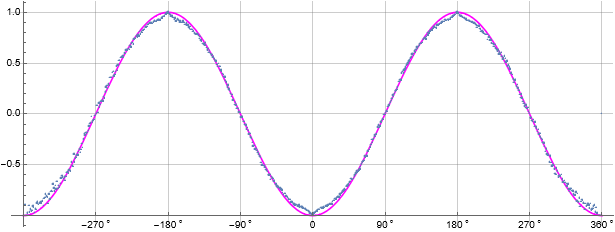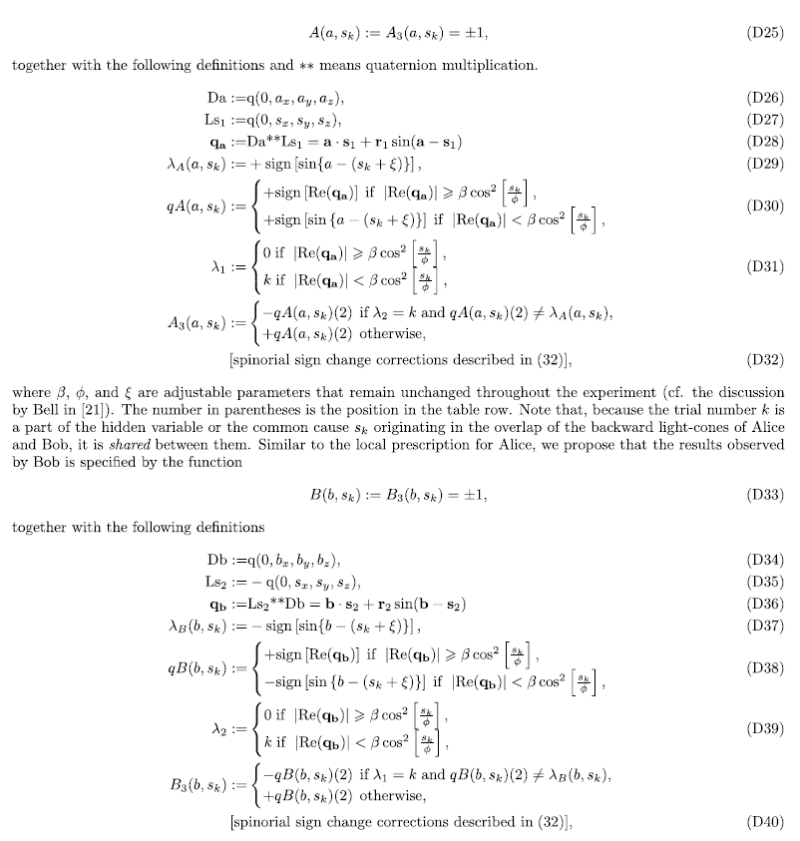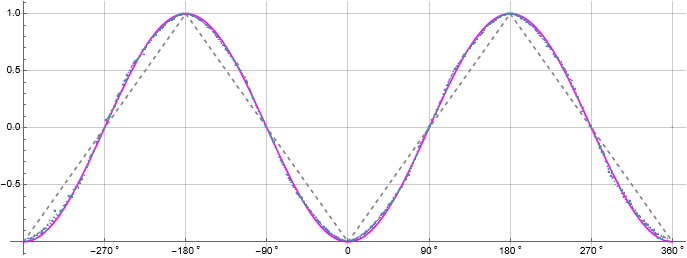Re: Coming Soon!
Re: Re: Coming Soon!
Brilliant Fred. You just proved that the scaler part of the product of two quaternions is equal to the cosine of the angle between them. I apologize for saying that you had an incorrect calculation. You should publish a paper on that result.
-
FrediFizzx
- Independent Physics Researcher
- Posts: 467
- Joined: Thu Nov 04, 2021 1:44 pm
- Location: N. California, USA
- Contact:
Re: Re: Coming Soon!
Apology NOT accepted! And..., you should try to understand the physics that the math represents by asking sensible questions instead of making really dumb comments. We will be happy to explain it to you.
.
-
Joy Christian
- Research Physicist
- Posts: 196
- Joined: Fri Nov 05, 2021 2:26 pm
- Location: Oxford, United Kingdom
- Contact:
Re: Re: Coming Soon!
The interesting part in the GA or quaternion model is not the scalar part, which is trivially the cosine of the angle between Alice's setting and Bob's setting. The interesting part is the non-scalar part and how it vanishes in the simultaneous measurement processes carried out by Alice and Bob. It is beautiful.FrediFizzx wrote: ↑Mon Jan 31, 2022 7:44 amApology NOT accepted! And..., you should try to understand the physics that the math represents by asking sensible questions instead of making really dumb comments. We will be happy to explain it to you.
.
-
FrediFizzx
- Independent Physics Researcher
- Posts: 467
- Joined: Thu Nov 04, 2021 1:44 pm
- Location: N. California, USA
- Contact:
Re: Re: Coming Soon!
Yes, it is. But they are both interesting because without representing the spin of the two particles by quaternions or GA bivectors, you end up with,Joy Christian wrote: ↑Mon Jan 31, 2022 8:14 amThe interesting part in the GA or quaternion model is not the scalar part, which is trivially the cosine of the angle between Alice's setting and Bob's setting. The interesting part is the non-scalar part and how it vanishes in the simultaneous measurement processes carried out by Alice and Bob. It is beautiful.FrediFizzx wrote: ↑Mon Jan 31, 2022 7:44 amApology NOT accepted! And..., you should try to understand the physics that the math represents by asking sensible questions instead of making really dumb comments. We will be happy to explain it to you.
(a.s)(s.b) + cross products that cancel,
a scalar result which does NOT give you the cosine of the angle between a and b. It is actually quite a simple thing that John is having trouble understanding.
.
-
FrediFizzx
- Independent Physics Researcher
- Posts: 467
- Joined: Thu Nov 04, 2021 1:44 pm
- Location: N. California, USA
- Contact:
Re: Coming Soon!
I'm promoting h1 and h2 to hidden variable mechanism status and renaming toFrediFizzx wrote: ↑Thu Jan 27, 2022 7:09 am Yep, another freakin' update. I was able to simplify the code for h1 and h2 quite a bit plus some other notation improvements and cleanup. h1 and h2 are simply the trial numbers for events less than the hidden variable mechanism now or 0 otherwise. 6 million trials; 1 degree resolution.
Cloud File.
https://www.wolframcloud.com/obj/fredif ... c-forum.nb
Direct Files.
sims/newCS-59-S3quat-3D-new-prodcalc-forum.pdf
sims/newCS-59-S3quat-3D-new-prodcalc-forum.nb
Enjoy! And thus the solution for the HUGE mystery.


.
-
FrediFizzx
- Independent Physics Researcher
- Posts: 467
- Joined: Thu Nov 04, 2021 1:44 pm
- Location: N. California, USA
- Contact:
 Re: Coming Soon!
Re: Coming Soon!
Here is a twist on the current simulation. Sort of based on Joy's updated 3-sphere model. The hidden variable mechanism is only on the spinorial sign changes. No more HV mechanism on what generates the main A and B outcomes.
The idea is that we end up with }\cos{(\eta_{sb})}-\sin{(\eta_{as})}\sin{(\eta_{sb})}) . 2 million events; 1 degree resolution.
. 2 million events; 1 degree resolution.

I just need to figure out how to smooth out the tit nipples on the positive and negative peaks.
Cloud File.
https://www.wolframcloud.com/obj/fredif ... D-forum.nb
Direct Files.
sims/newCS-62-S3quat-3D2D-forum.pdf
sims/newCS-62-S3quat-3D2D-forum.nb
Enjoy!
.
Code: Select all
qA = Sign[Re[qa] + (Sin[(a - ss[[k]] + \[Xi]) Degree])/4];
qB = Sign[Re[qb] - (Sin[(b - ss[[k]] + \[Xi]) Degree])/4];
I just need to figure out how to smooth out the tit nipples on the positive and negative peaks.
Cloud File.
https://www.wolframcloud.com/obj/fredif ... D-forum.nb
Direct Files.
sims/newCS-62-S3quat-3D2D-forum.pdf
sims/newCS-62-S3quat-3D2D-forum.nb
Enjoy!
.
-
FrediFizzx
- Independent Physics Researcher
- Posts: 467
- Joined: Thu Nov 04, 2021 1:44 pm
- Location: N. California, USA
- Contact:
 Re: Coming Soon!
Re: Coming Soon!
Well, couldn't figure how to smooth out those tit nipples on that last simulation so just did some clean up and notation changes on the spinorial sign change simulation. What is actually going on with this simulation is that the spinorial sign changes are corrections to the raw A and B data that are done in the analysis stage. IOW, the A and B data along with the hidden variable mechanism data is sent to the analysis so that the A and B data can be corrected. That makes everything completely local. 5 million trials; one degree resolution

Cloud File.
https://www.wolframcloud.com/obj/fredif ... forum5m.nb
Direct Files.
sims/newCS-64-S3quat-3D2D-pc-forum5m.pdf
sims/newCS-64-S3quat-3D2D-pc-forum5m.nb
Enjoy! So, now there is no doubt that this simulation destroys Bell's junk physics theory and Gill's junk math theory!


.

Cloud File.
https://www.wolframcloud.com/obj/fredif ... forum5m.nb
Direct Files.
sims/newCS-64-S3quat-3D2D-pc-forum5m.pdf
sims/newCS-64-S3quat-3D2D-pc-forum5m.nb
Enjoy! So, now there is no doubt that this simulation destroys Bell's junk physics theory and Gill's junk math theory!
.
-
FrediFizzx
- Independent Physics Researcher
- Posts: 467
- Joined: Thu Nov 04, 2021 1:44 pm
- Location: N. California, USA
- Contact:
Re: Coming Soon!
For those that are Mathematica challenged, here are the analytical formulas for A and B as a PDF file.
sims/Event_by_Event_EPR-Bohm_Simulation_A-B.pdf
As a picture.

Questions, comments?
.
sims/Event_by_Event_EPR-Bohm_Simulation_A-B.pdf
As a picture.

Questions, comments?
.
-
gill1109
- Mathematical Statistician
- Posts: 204
- Joined: Thu Nov 04, 2021 10:17 pm
- Location: Apeldoorn, Netherlands
- Contact:
Re: Re: Coming Soon!
I have two questions:
1) What does the argument “(2)” mean in equations D32 and D40?
2) I see that A defined in D25 depends on lambda_2, and lambda_2 depends on q_b, which depends on b. (And similarly for B …). How would this be realised physically without action at a distance?
1) What does the argument “(2)” mean in equations D32 and D40?
2) I see that A defined in D25 depends on lambda_2, and lambda_2 depends on q_b, which depends on b. (And similarly for B …). How would this be realised physically without action at a distance?
-
FrediFizzx
- Independent Physics Researcher
- Posts: 467
- Joined: Thu Nov 04, 2021 1:44 pm
- Location: N. California, USA
- Contact:
Re: Re: Coming Soon!
"The number in parentheses is the position in the table row." Sorry, there is some text before this that explains it but if you compare with the simulation you know that outqA is a table with two columns. One for the angle and one for qA result.gill1109 wrote: ↑Fri Feb 11, 2022 10:28 pm I have two questions:
1) What does the argument “(2)” mean in equations D32 and D40?
2) I see that A defined in D25 depends on lambda_2, and lambda_2 depends on q_b, which depends on b. (And similarly for B …). How would this be realised physically without action at a distance?
Eqs. (D32) and (D40) for the spinorial sign change corrections are done in the first analysis phase. The data for A and B are brought together for analysis.
.
Re: Re: Coming Soon!
Fred left out the important part of his calculation. The two loops shown above generate the data for later analysis. The non-local part is in the section of the program called "spinorial sign changes", not shown above. Here, the variable lambda1, generated in the Alice loop is used to make changes to Bob's data. The same process is carried out on Alice's data using the variable lambda2, which was generated in Bob's loop. These are clearly non-local calculations. This can be proven by leaving out the spinorial sign changes. The resulting graph will be the familiar triangle.
-
FrediFizzx
- Independent Physics Researcher
- Posts: 467
- Joined: Thu Nov 04, 2021 1:44 pm
- Location: N. California, USA
- Contact:
Re: Re: Coming Soon!
John, you must be partially blind. Look again and try to understand what I wrote. The spinorial sign change correction to the raw A and B data is done in the analysis stage where the A and B data is brought together. It's completely local.jreed wrote: ↑Sat Feb 12, 2022 10:07 am Fred left out the important part of his calculation. The two loops shown above generate the data for later analysis. The non-local part is in the section of the program called "spinorial sign changes", not shown above. Here, the variable lambda1, generated in the Alice loop is used to make changes to Bob's data. The same process is carried out on Alice's data using the variable lambda2, which was generated in Bob's loop. These are clearly non-local calculations. This can be proven by leaving out the spinorial sign changes. The resulting graph will be the familiar triangle.
.
Re: Re: Coming Soon!
I don't care what you are saying. I just look at the Mathematica program, which I understand perfectly. The non-local calculation is obvious, as I've stated before. You keep changing the variable names, but the non-locality is always the same.
-
FrediFizzx
- Independent Physics Researcher
- Posts: 467
- Joined: Thu Nov 04, 2021 1:44 pm
- Location: N. California, USA
- Contact:
Re: Re: Coming Soon!
Well, I don't care what you are saying either. You haven't proven non-locality like I told you what you have to do. If the spinorial sign change corrections are done in the analysis stage, then it is purely local. The A and B data have to come together for analysis. And everything for the spinorial sign change corrections are hidden variable mechanisms. That data also goes to the analysis. But ultimately it is part of how Nature does the correlations. It is irrelevant that we don't know the exact way Nature is doing it but it is a possible emulation of how Nature does it completely local.
A problem with these types of simulations is the sign function. It is inherently a linear function so you have to do whatever it takes to make it non-linear. You can see in Joy's updated 3-sphere model that you get the -a.b prediction when you don't have to deal with sign functions. That destroys Bell junk physics theory right off the bat; this simulation destroys Gill's junk math theory. Bell's theory is already dead. And not much you can do about that except moan.
.
-
FrediFizzx
- Independent Physics Researcher
- Posts: 467
- Joined: Thu Nov 04, 2021 1:44 pm
- Location: N. California, USA
- Contact:
Re: Coming Soon!
Some more improvements on the code and I have combined the CHSH analysis into the main program.FrediFizzx wrote: ↑Wed Feb 09, 2022 1:46 pm Well, couldn't figure how to smooth out those tit nipples on that last simulation so just did some clean up and notation changes on the spinorial sign change simulation. What is actually going on with this simulation is that the spinorial sign changes are corrections to the raw A and B data that are done in the analysis stage. IOW, the A and B data along with the hidden variable mechanism data is sent to the analysis so that the A and B data can be corrected. That makes everything completely local. 5 million trials; one degree resolution
Cloud File.
https://www.wolframcloud.com/obj/fredif ... forum5m.nb
Direct Files.
sims/newCS-64-S3quat-3D2D-pc-forum5m.pdf
sims/newCS-64-S3quat-3D2D-pc-forum5m.nb
Enjoy! So, now there is no doubt that this simulation destroys Bell's junk physics theory and Gill's junk math theory!


CHSH = 2.81439!
Cloud File.
https://www.wolframcloud.com/obj/fredif ... orum-5m.nb
Direct Files.
sims/EPR-Bohm_simulation_CHSH-forum-5m.pdf
sims/EPR-Bohm_simulation_CHSH-forum-5m.nb
.

